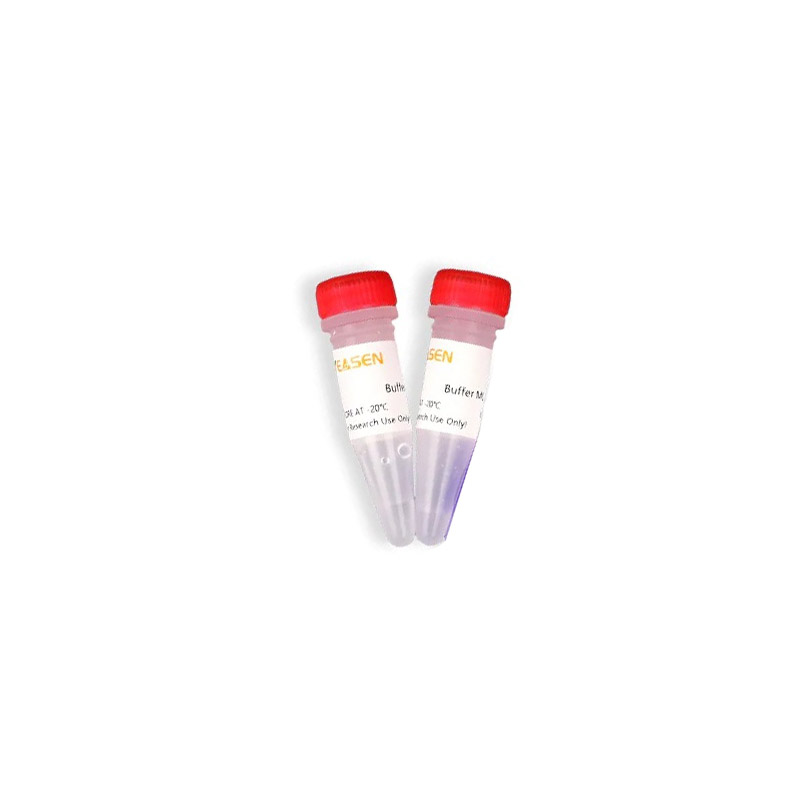Mouse Tissue/ Cell Lysis Reagent
Product description
The kit is equipped with a powerful lysis buffer, which can quickly lyse samples (e.g. cells, mouse tail, mouse ear, mouse toe, muscle, etc.) to release genomic DNA, and the lysate can be directly added to the PCR reaction system without purification, which is convenient for operation. In addition, this kit requires low sample input, 5 mg of mouse tissue or 1-5 mm of mouse tail can be used for experiments.
Components
|
Components No. |
Name |
19697ES50 |
19697ES70 |
|
19697-A |
Buffer ML |
5 × 1 mL |
1 × 20 mL |
|
19697-B |
Buffer MT |
0.6 mL |
2 × 1.25 mL |
Storage
19697-A (Lysis Solution) should be stored at 2~8℃ for 1 years. If used multiple times, please freeze in separate packages to avoid cross-contamination. 19687-B (Stop Solution) should be stored at -25~-16℃ for 1 years.
Instructions
Mouse Genomic DNA Release
- Clip 5-10 mg of animal tissue or 1-5 mm mouse tail in a 1.5 mL centrifuge tube*.
- Add 90 μL of Buffer ML to the above centrifuge tube, vortex gently to completely infiltrate the sample with the lysate, and centrifuge briefly.
- Incubate at 95°C for 15 min in a thermostatic incubator**.
- Add 10 μL of Buffer MT, flick to mix, and terminate lysis.
- Optional step: centrifugation at 12000 rpm for 2 min.
- Transfer the supernatant to a new centrifuge tube and store at 4°C or -20°C or take the supernatant directly for subsequent PCR amplification.
* Tissue should be cut up as much as possible to allow the lysis reaction to proceed more smoothly.
**Incubation at 95°C for 15 min is generally sufficient for most PCR needs. If a larger amount of DNA is required or the sample is difficult to lyse, the time can be extended to 30 min. The tissue block does not need to be completely lysed, and the residue can be removed in a subsequent centrifugation step.
Cell Genomic DNA Release
After culturing transfected cells in a 48-well-plate for 3 days and reaching a cell density of about 70,000 cells/well, remove the medium as completely as possible. Then add 90ul of ML buffer directly per well and pipette each well. Transfer all to the 96 well-PCR plate. After treating with a PCR machine at 95 °C for 5-15 min and cooling down, add 10ul MT buffer and blow evenly and thoroughly. Using high-fidelity enzyme (Cat# 10164) or Taq enzyme, add 0.5-2ul cell lysate to every 50ul of PCR reaction system and perform PCR.
Notes
1. This product is for research use only.
2. Please operate with goggles, lab coats and disposable gloves for your safety.
3. In order to avoid cross contamination between samples, it is necessary to immerse the edge of the sampling device or the part in direct contact with the sample in 2% sodium hypochlorite solution after each sampling, wash it several times, and then dry the residual liquid with a clean paper towel before using it again. For the convenience of the test, several sampling devices can be prepared and cleaned uniformly after use to ensure that each individual sample is sampled with a contamination-free sampling device.
4. It is recommended to use freshly taken animal tissues. In case of long-term frozen tissues, repeated freezing and thawing should be avoided as much as possible, otherwise it will lead to degradation of the template and affect the PCR efficiency.
Catalog No.:*
Name*
phone Number:*
Lot:*
Email*
Country:*
Company/Institute:*

